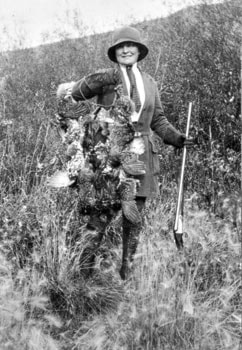It was the lure of gold that drew the fearless Martha Black to the Yukon, but it was the awesome beauty of the wild country that caused her to stay.
Martha was born to a wealthy family in Chicago, Illinois in 1866. She was five during the great Chicago fire of 1871.
After completing finishing school, where she excelled in elocution and botany, Martha married Will Purdy in 1887 and had two sons.
When news of the Klondike Gold Rush reached her, she left her sons with her parents and headed north with her brother. Together they climbed the Chilkoot Pass and sped through the treacherous waters of Miles Canyon without incident.
They reached the Klondike and set up house in Lousetown, across the river from where Dawson City is located today. Soon Martha realized she was pregnant and gave birth to her third son, Lyman, in 1899.
In 1901 Martha was granted a divorce from her husband and settled in the Klondike. She purchased a piece of land and built a sawmill. The legal matters arising from this transaction caused her to meet George Black, a lawyer from New Brunswick who was practising in Dawson.
Two years later they were married.
A staunch Conservative, George first held public office as a member of the Yukon Council in 1905. Martha worked tirelessly campaigning for him.
The Blacks loved the outdoors and spent as much time as possible hunting, fishing and camping. Martha loved to walk for miles seeking out unique species of wildflowers, which she would press on a page of water-colour paper — a process she called “artistic botany.”
Over the years, Martha became well known for her floral pictures.
And, in 1909, when the Yukon government offered a prize for the best exhibit of native flowers Martha enlisted the help of Dawson City residents to gather 464 different varieties and win the prize.
For the following two summers Martha was commissioned by the Canadian Pacific Railway to gather and mount wildflowers for their stations and hotels.
The MacBride Museum of Yukon History holds a large collection of artifacts that were donated by the Blacks, including examples of Martha’s artistic botany. A few of the framed, pressed flowers are on display in the museum’s new Gold to Government gallery.
In 1909, the Blacks moved to Vancouver, but in 1911 George was appointed seventh commissioner of the Yukon territory. So, the following year, George, Martha and Lyman returned to Dawson.
During the First World War, Martha worked tirelessly to support the war effort through the International Order of the Daughters of the Empire and Red Cross charity work.
George wanted to do his part and, in 1916, he resigned from his position as commissioner to enlist. This unselfish act sparked a great deal of local support for the war effort and more than 200 men — 10 per cent of the population of Dawson at that time — followed Black into war.
When the Yukon contingent was ready to leave home, Martha refused to be left behind.
She travelled to England and immediately resumed her activities. She administered the Yukon Comfort Fund, distributed parcels assembled at home by the IODE, visited the wounded and ill, and sent frequent reports home to Canada for publication.
After the war ended and the Armistice was signed, the Blacks returned to Canada, where George was elected Yukon’s Member of Parliament.
He held that position for four consecutive terms, from 1921 to 1935, when ill health temporarily forced him to resign.
In the next election Martha, who was nearly 70 at that time, ran in George’s place and she won the seat to become the second woman to hold national political office in Canada.
George returned to public office after his recovery and, a few years later in 1944, the Blacks bought a house in Whitehorse.
In 1948 Martha was awarded the Order of the British Empire for cultural and social contributions to the Yukon.
When Martha died in 1957, her casket was covered with both an American and Canadian flag. She is buried in the Pioneer Cemetery on Sixth Avenue in Whitehorse.
This column is provided by the MacBride Museum of Yukon History. Each week it will explore a different morsel of Yukon’s modern history. For more information, or to comment on anything in this column e-mail lchalykoff@macbridemuseum.com.
